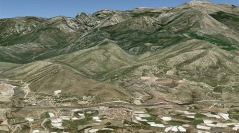

 Comptes Rendus Palevol
14 (5) - Pages 411-422
Comptes Rendus Palevol
14 (5) - Pages 411-422This study examines 100 charred plant macroremains from the inner galleries of Cueva de Nerja in order to better understand the context of Palaeolithic rock art and obtain information about possible lighting systems. The remains were retrieved on the surface, very close to Palaeolithic cave paintings, and also from inside possible points of fixed lighting. The predominant wood-type is Pinus sp., especially Pinus tp. sylvestris/nigra. The taphonomic alterations recorded are attributable to the combustion process (vitrification and cracks), the possible gathering of dead wood (fungal hyphae/mycelia), the use of branches and twigs (reaction wood) and the burning of resinous taxa (resin marks). The identification of a vegetative bud of Pinus sylvestris furnishes information about the use of tree branches, as well as the time of year at which the Cueva de Nerja may have been frequented by prehistoric groups.
Wood charcoal analysis, Taphonomy, Inner archaeological context, Parietal art, Upper Palaeolithic